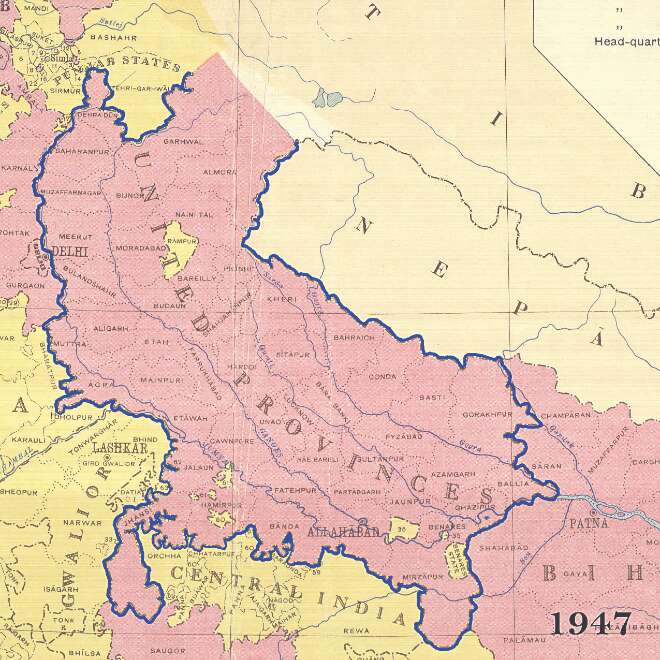Naming the hindi heartland
The need for a new noun was felt as ‘United Provinces’ didn’t resonate with the identity of people and the profound metamorphosis of the state during the 1940s-50s

At the very outset, let me acknowledge that the pith and substance of this column is derived from Gyanesh Kudasiya's seminal work 'Region, Nation, "Heartland": Uttar Pradesh in India's Body Politics' which covers the crucial period of 1947-54, supplemented by Robert King's 'Nehru and the Language Politics of India', besides of course, the back issues of 'Economic Weekly', as the EPW was then called.
Unlike Punjab and Bengal, the United Provinces as called then, did not endure a division of its territory or suffer the horrific violence that many other parts of north India experienced. Its metamorphosis in the late 1940s and the early 1950s was profound nonetheless. It is true that there was an out-migration of several Muslim families including government employees and professionals, and many Punjabi families came to settle in Kanpur, Allahabad and towns like Ghaziabad, Saharanpur and Meerut. Most of this movement was voluntary. But the numbers were not significant enough for the creation of a rehabilitation department as in West Bengal and East Punjab. However, the social fabric of the state had been deeply affected by communal incidents across the country.
Since 1902, the province had been known as the United Provinces of Agra and Oudh. In 1937, this extended nomenclature was shortened to the United Provinces or UP. Although the High Court continued at Allahabad, the provincial capital was shifted to Lucknow in 1937 — perhaps the increasing national consciousness in Allahabad led the provincial government to shift its base to the less politically inclined city with a greater focus on cultural refinements, cuisine and the arts. Interestingly, in the map of 1947, Allahabad was marked out as the capital of UP, but in the 1950 map, the correction had been made. By this time, the territory of UP also included the erstwhile princely states of Tehri Garhwal, Benares and Rampur.
While there was a general consensus that United Provinces held no meaning in independent India, a consensus on the new name was not easy. As Kudasiya writes, "Place names can be deeply symbolic and serve as an ideological device to imprint a culturally constructed identity on a given physical space. They provide an intersection between hegemonic ideological structures and spatial practices of everyday life. They connect physical territory to a history and a commemorative past. In post-colonial UP, place names became an important aspect of the post-colonial order."
A few days after Independence, a debate started in the UP Legislative Assembly over the question of a "suitable name" for the province. In the debate on September 11, 1947, Chandra Bhal, a Congress MLC, rose to move a motion for changing UP's name: "We are witnessing a new birth. I think we should have a new and suitable name. After the birth, the most important ceremony is the 'naam karan' everywhere and I think we should signalize this birth of a new age and a new life in our people by having a really good name for our province."
Meanwhile, the names of most rivers and towns were changed to align their pronunciation with the prevalent practice. Prominent amendments included "Ganga" for the Ganges and "Mathura" for Muttra. A subsequent notification produced a list of "authentic" spellings rectifying the names of rivers and cities. So, Jumna became "Yamuna" and Gumti became "Gomti". Similarly, Ayodhya, Kanpur, Faizabad and Unnao were new spellings of prominent cities. National Herald called it "Indianisation or nationalisation" of place names.
Legislator Chandra Bhal seems to have been at the forefront of the many discussions and debates on the subject. He put forth several suggestions: "The name of Oudh can be extended to the whole province. Oudh is an old name, the kingdom of Rama, which would be acceptable to all communities and parties and it is true that today that name is confined to only two divisions comparing 12 districts. But in history expansions have taken place.'
Education Minister Sampurnanand disagreed vehemently. He pointed out the difficulties in adopting Oudh as the new name. "Braj Basi (the residents of Braj) cannot accept Oudh as our province and the people at Kashi and Mathura also cannot accept Oudh as its name." In doing so, he highlighted the distinct cultural regions existing within the province. Chandra Bhal clarified later that Oudh was merely an example. Other possible names could be "Aryavarta" or even "Hindustan". He also suggested that "United Provinces" could also be retained as it could be rendered in any language according to the speaker's choice. It could be Samyukta Prant in Hindi, or Munalik Mutahdda in Urdu, or United Provinces in English. Speakers after speakers rose to argue that United Provinces as a colonial appellation was unsuitable, as the people of the province simply did not identify with it. They could not be expected to feel patriotic about such a name for it simply did not reflect their local identity.
Soon the debate seemed to settle over "Aryavarta". Speaking in support of this, legislator Pandit Badri Datt Pande said: "When Aryans came here, they called it Aryavarta or the abode of Aryans. I think this is the original name. The Aryans came here and settled and they wrote these wonderful books, the Vedas, the Darshans and other systems of philosophy. Let it be called Aryavarta."
....to be continued
The writer is the Director of LBSNAA and Honorary Curator, Valley of Words: Literature and Arts Festival, Dehradun.
Views expressed are personal



